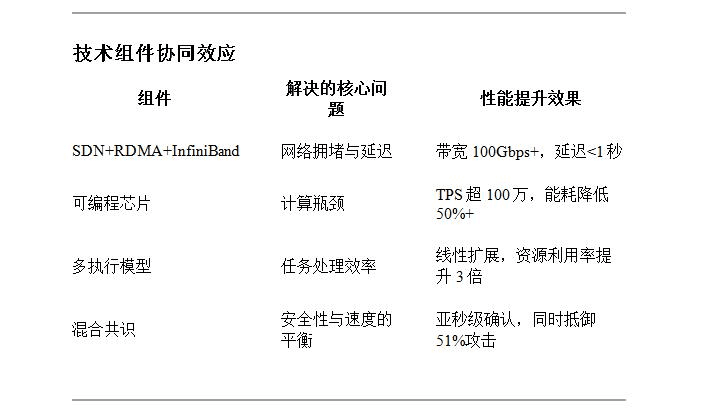The InfiniSVM hardware acceleration architecture of Solayer achieves a breakthrough in performance with millions of TPS and near-zero latency by offloading the core components of the blockchain to dedicated hardware. Its key technical components include the following four parts, which together build a high-performance, low-latency blockchain infrastructure:
1. Dedicated Hardware Technology Combination
(1) SDN (Software Defined Networking)
Function: Dynamically allocates network resources, optimizes data transmission paths, and reduces congestion and latency.
Application Scenario: Real-time adjustment of bandwidth allocation between blockchain nodes to ensure high-priority transactions (such as high-frequency dApp requests) are processed first.
(2) RDMA (Remote Direct Memory Access)
Function: Bypasses the operating system kernel to directly transfer data between node memories, eliminating CPU overhead.
Performance Improvement: Reduces data transmission latency from milliseconds to microseconds, supporting real-time transaction confirmation.
(3) InfiniBand Network
Function: Provides 100Gbps+ bandwidth, supporting large-scale parallel computing.
Technical Advantage: Compared to traditional Ethernet, InfiniBand's low latency and high throughput are more suited to the high-frequency trading demands of blockchain.
(4) Programmable Chips (FPGA/ASIC)
Function: Custom hardware accelerates core blockchain operations (such as signature verification and hash computation).
Case: Solayer offloads compute-intensive tasks such as transaction verification and consensus algorithms to FPGA, achieving 10-100 times performance improvement over CPU.
2. Multi-Execution Model Expansion
(1) Dynamic Task Allocation
Mechanism: Dynamically allocates different execution units (CPU, GPU, FPGA) based on transaction types (such as staking, payments, gaming).
Effect: Avoids single-point performance bottlenecks, achieving linear scalability (TPS increases with the number of nodes).
(2) Parallel Processing
Technology: Breaks down blockchain state updates, transaction execution, and other operations into independent subtasks for parallel processing.
Data Support: The InfiniSVM architecture can handle over 1 million transactions per second, far exceeding the 15-30 TPS of traditional blockchains.
3. Hybrid Consensus Mechanism
(1) Proof of Authority (PoA)
Function: Quickly generates blocks by preset authoritative nodes, reducing consensus latency.
Applicable Scenarios: High-frequency trading scenarios (such as payments, gaming) requiring sub-second confirmation.
(2) Proof of Stake (PoS)
Function: Elects validators through token staking to ensure decentralized security.
Balancing Strategy: Solayer adopts PoS for key transactions (such as cross-chain and stablecoin issuance) to ensure security.
(3) Dynamic Switching
Innovation: Automatically switches consensus modes based on network load (e.g., using PoA to speed up during peak times, and PoS to enhance security during off-peak times).
4. Node Data Synchronization and Security
(1) Real-time State Alignment
Mechanism: Ensures real-time synchronization of all nodes' states through a hardware-accelerated P2P network.
Technical Tools: Combines RDMA and InfiniBand to reduce state synchronization latency to the microsecond level.
(2) Security Reinforcement
Measures:
Hardware-level Encryption: Integrates encryption modules in FPGA/ASIC to protect transaction data.

Summary
Solayer's InfiniSVM architecture achieves a qualitative change in blockchain performance through four major components: dedicated hardware (SDN/RDMA/InfiniBand/FPGA), multi-execution model parallelization, hybrid consensus mechanism, and real-time data synchronization. Its technical path breaks the limits of traditional software scalability, providing a viable solution for high-frequency dApps (such as trading, gaming, and payments). Investors need to pay attention to the progress of Solayer Chain's launch in 2025 to verify the actual effectiveness of the hardware acceleration architecture.